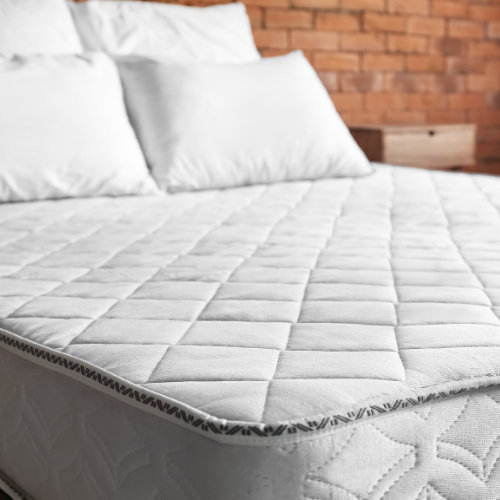Introduction
Back pain is one of the most common complaints I hear in clinic, with many factors contributing to it, from lifestyle habits to posture. However, there’s one factor you might be overlooking: your bed or mattress. Could the place where you spend a third of your life be impacting your back health? I get asked this frequently in clinic so let’s investigate.
How Your Mattress Affects Your Back
Your mattress plays a crucial role in supporting your spine while you sleep. Ideally, it should keep your body in a neutral position, where your spine maintains its natural curve, and your shoulders, hips, and heels are properly aligned. If your mattress is too soft, too firm, or worn out, it could cause improper alignment, leading to back pain or exacerbating existing issues.
The Importance of Spinal Alignment
When lying down, your mattress should help keep your spine aligned in the same way it is when you’re standing. If your spine isn’t properly supported, certain areas may experience excess pressure. Over time, this can lead to muscle stiffness, tension, and persistent back pain, especially in the lower back.
Signs Your Mattress Could Be the Culprit
Not sure if your mattress is the source of your discomfort? Here are some signs that might indicate it’s time to reconsider your sleep setup:
1. Morning Back Pain
Waking up with stiffness or pain in your lower back that improves throughout the day is often a sign that your mattress may be having an impact on your pain. A supportive mattress should leave you feeling rested and refreshed, not stiff or sore. It’s also telling you that your back likes to move. If you have morning stiffness then these simple stretches could help.
2. Worn-Out Mattress
If your mattress is more than 7-10 years old, it’s likely lost its ability to provide proper support. Over time, mattresses sag or develop indentations, which can interfere with spinal alignment and lead to back discomfort. It’s a good idea to turn your mattress to reduce the impact of this regularly. Just be careful when turning your mattress – it is not a 1 person’s job – unless you want a bad back!
3. You Sleep Better Elsewhere
If you notice your back pain lessens or disappears after sleeping in a different bed, such as at a hotel or on a friend’s mattress, it might be a sign your mattress isn’t providing the right support. Try other beds in the house.

REGAIN CONTROL OVER YOUR KNEE. Learn More about my FREE masterclass – Click Here.
The Impact of Mattress Firmness
The firmness of your mattress plays a significant role in back health. However, the best firmness level varies depending on individual needs and preferences.
1. Too Firm
A very firm mattress can push on pressure points like your shoulders and hips, creating poor alignment and unsupported areas. Especially if you have a curvy body shape. This rigidity can increase tension in your lower back, leading to discomfort over time.
2. Too Soft
On the flip side, a mattress that is too soft might allow your body to sink in too deeply, especially around your hips and lower back. This lack of support can cause your spine to spend long periods in positions that are not ideal, leading to morning aches and stiffness.
3. Medium-Firm is Ideal
Research often suggests that a medium-firm mattress offers the best balance of comfort and support for most people with back pain. This firmness level allows for proper spinal alignment while also providing enough cushioning to relieve pressure on joints.
Other Factors to Consider
1. Sleeping Position
Your preferred sleeping position can affect how your mattress impacts your back. Side sleepers need more cushioning to keep their hips and shoulders aligned, while back sleepers need firm support to prevent the lower back from sinking too much. Stomach sleepers require a firmer mattress to keep their spine from arching uncomfortably. Take a look at this blog for more guidance on finding comfortable sleeping positions with back pain.
2. Pillow Support
Your pillow also plays a crucial role in maintaining spinal alignment, especially for back and side sleepers. Using a pillow that’s too high or too flat can put a strain on your neck and upper back, contributing to overall discomfort.
3. Body Weight and Body Shape
Your body weight can influence how a mattress feels. Heavier individuals may find that a softer mattress doesn’t offer enough support, while lighter individuals may experience discomfort on a firmer surface. This is another reason why a medium-firm mattress tends to be a good middle ground for most people. For those of you like myself who have a pear-shaped figure or curves anywhere then the gaps need supporting. Mattresses that are too firm will not mould to your curves. I’m a great lover of memory foam to fill the gaps with a firm support underneath.
When to Seek Professional Help
If you’ve changed your mattress and adjusted your sleep setup but still experience back pain, it may be time to consult a healthcare professional. A physiotherapist can help determine if your back pain is caused by other factors, such as poor posture, muscle weakness, or other underlying conditions. My FREE Back Pain Masterclass is a good place to start, to find out more click here and I hope to see you there.
You may find these blogs helpful
The Powerful Connection Between Sleep, Healing, and Pain: Why Rest is Your Best Medicine
Sleeping well with pain – Proven Strategies for a Restful Night
The Worst Sleeping Positions for Back Pain – And How to Fix Them
Finding Comfort in the Night: The Best Sleeping Positions for Back Pain Relief
Conclusion
While a mattress might not be the sole cause of your back pain, it can significantly impact your spinal health and comfort. Choosing a mattress that supports proper alignment and offers the right level of firmness for your needs can make a world of difference in managing back pain. If you’re waking up with aches and pains, it could be worth considering whether your mattress is contributing to the problem. After all, quality sleep is essential for healing and overall well-being.
Take care, Helen
Helen Manders BSc (Hons) MCSP HCPC
Chartered Physiotherapist Since 2001



